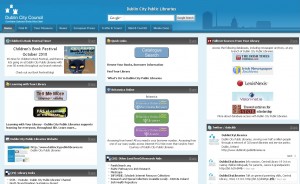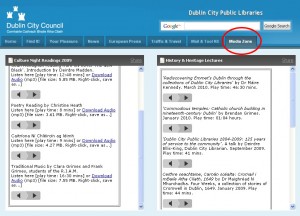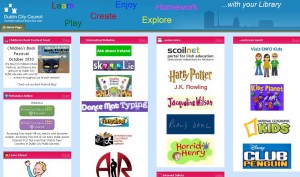Netvibes for Centralised Management of the Internet Desktop
Posted by guestblogger on November 8th, 2010
About this Guest Post
Eddie Byrne is a Senior Librarian with Dublin City Public Libraries, Dublin, Ireland, and Head of the Libraries’ Web Services Unit. In the public library service since 1980, his experiences extend to website development, content management systems, open source software, web accessibility, cataloguing, metadata, thesaurus construction, and of course Web 2.0. He can be contacted at edward.byrne@dublincity.ie
Netvibes for Centralised Management of the Internet Desktop
Dublin City Public Libraries is the largest public library authority in the Republic of Ireland, serving a population in excess of half a million. Free public Internet access is available on over 100 Internet computers in 21 locations across the city, and in 2009 alone there were over 380,000 Internet sessions. Free wi-fi is also available.
Due to the number of locations and PCs, computer and desktop management has always proved a challenge. It had long been apparent that a solution was needed that would in the first instance provide library Internet users with a useful and well presented Internet desktop, while at the same time ease the task of desktop management. Prior to the introduction of the Internet start page solution, the practice had been, as and when required, to highlight select websites by placing Internet shortcuts on an already cluttered computer desktop, adding website addresses to a browser’s list of favourites, while also having to edit existing links as and when necessary. This process had then to be replicated on each of the over one hundred PCs in the many and diverse locations, a time and resource consuming task for the Libraries’ IT Unit. It was at the same time debatable as to whether or not these efforts were of any real benefit to the Internet user.
Our Solution
The obvious solution was a centrally managed and purposely designed default home page or ‘Internet desktop’, with changes applied in one location taking immediate effect across the whole network of Internet PCs. From a management perspective this would result in huge savings in terms of time and staff involvement. It also afforded the opportunity to some degree to monitor usage of the custom delivered desktop and as a consequence improve it as necessary.
In late 2007, various solutions were looked at, including a number of web-based start page services. A web-based solution quickly became the front-runner in terms of cost, available time, and ease of delivery, tied in to available staff resources and expertise. Pageflakes, having been found to meet certain minimum requirements, was eventually selected and a custom-built Pageflakes page rolled out in early 2008 as the default entry point to the web on all public-access PCs. All this work was carried out internally, with no recourse to third-party developers or service providers, and consequently no third-party costs. Netvibes replaced Pageflakes in late 2008 consequent on issues experienced with Pageflakes, issues which highlighted the need to have a risk management plan in place.
The ‘Start Page’
The newly delivered Internet desktop, or ‘start page’, acted as a ‘portal’ or gateway, giving library users a single point of access to information and services on the web, while also presenting information from diverse sources in a unified manner. See http://www.netvibes.com/dublincitypubliclibraries/
In terms of structure and substance, content is delivered by means of eight tabs, each tab representing a different category. These are: – Home (default page), Find It!, News, European Press, Your Pleasure, Traffic & Travel, Mail & Tool Kit and Media Zone. Most of the tabs incorporate some library-related content (event and service promotions, announcements), the Home tab in particular having a particular library focus.
In terms of measuring usage, Google Analytics is used to collate statistical data, with a different script collecting data on each tab, thereby allowing analysis of use of each category of content.
The desktop is managed by the Libraries’ Web Team and management entails ongoing monitoring of the ‘Start Page’, checking for downtime, performance issues, widget failure, broken links, and carrying out periodic manual edits; the bulk of the content is generated dynamically via RSS feeds from the Libraries’ other web presences including its Twitter account and delicious bookmark site, as well as the astute use of the various widgets available to deliver diverse content.
In real terms, the management of the desktop can now be measured in terms of minutes per day, with additional time spent periodically carrying out a more extensive audit and analysis of use. Of greater note of course is the fact that the library service is now providing a value-added service for its users, one available not merely via the library-based Internet PCs but from any location where one can access the Internet.
Further Developments – Children’s Internet Computers
Towards the end of 2009 work began on developing a separate purposely designed Internet desktop using the Netvibes platform for use on the dedicated children’s Internet computers in branch libraries. Because of the particular target audience, security concerns were paramount, and having to get the approval of the Libraries’ parent organisation (City Council) resulted in time delays and additional work in addressing concerns, real and imaginary. As a consequence, access on dedicated children’s computers is restricted to select sites, and as a risk minimisation effort it was decided to restrict the use of widgets on the resulting page to those built, maintained and hosted by Netvibes alone. This desktop is due for rollout in Autumn 2010.
See http://www.netvibes.com/dublincitypubliclibraries-learningzone#Home_Page
Future developments – Business Information Centre Internet Computers
As of late summer 2010, a purposely designed desktop is being investigated for use in the Business Information Centre, a specialist service housed in the main Central Library.
To Find Out More
The article author, Eddie Byrne, gave a presentation on the use of a start page service by a public library at the Internet Librarian International conference in London in October 2009, see the presentation at: http://www.slideshare.net/ebyrne41/using-a-personalised-start-page-service-to-deliver-a-public-library-portal



